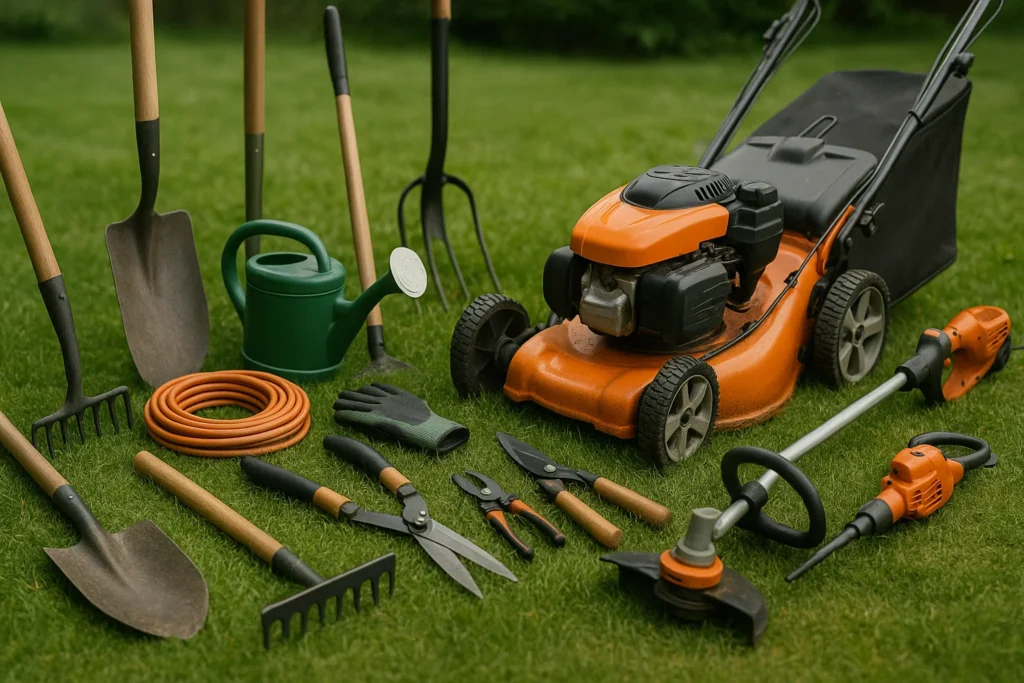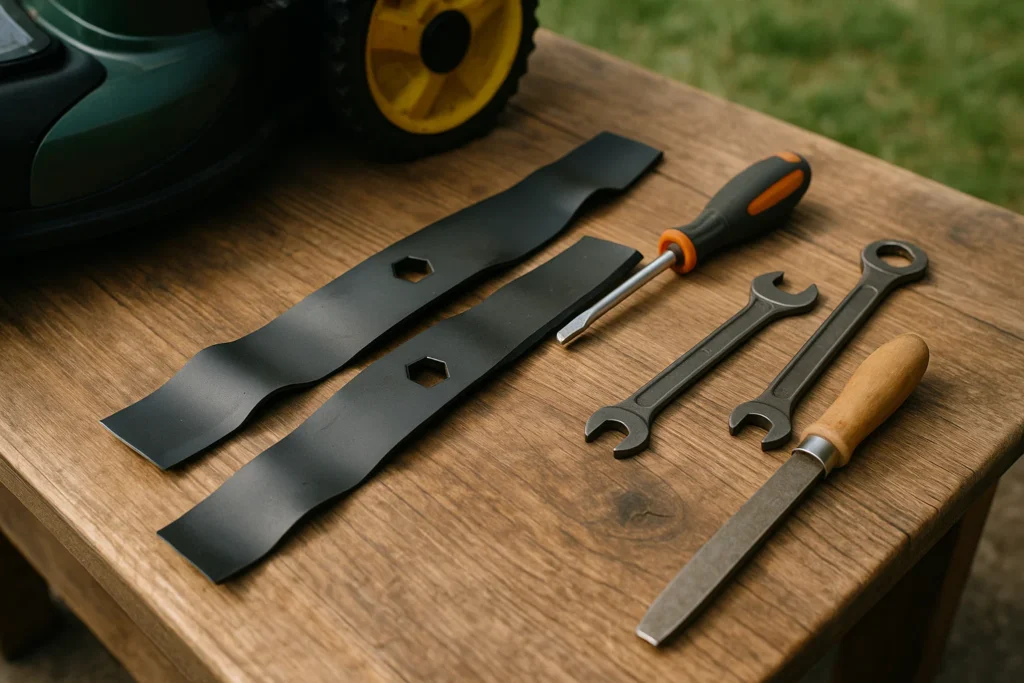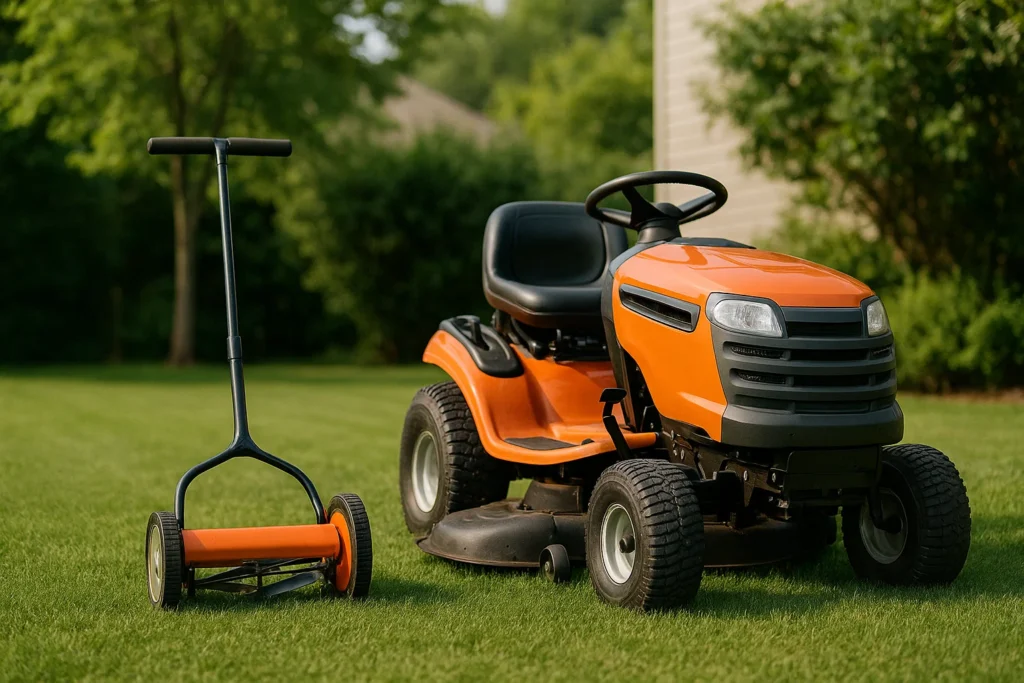Lawn care equipment is the base for any healthy, beautiful yard. For homeowners, having the appropriate tools not only makes it easier to keep up with their lawn but ensures that it will last and look the way nature intended. Quality equipment for lawn care helps the power be put in the homeowners’ hands regarding their yard health and appearance.
Your choice of lawn care service tools depends on a lot of factors: the size of the lawn, the grass type, the lay of the land, and whether or not you want to use manual or powered tools. Also, choosing tools with interchangeable batteries, if they’re electric, helps simplify your toolkit. In this guide, we’ll discuss must-have lawn care tools for every homeowner and how using them the right way can change the look of your outdoor space.
Top 20 Lawn Care Tools You Need
The lawn care tools help to keep your yard looking nice and healthy. Mowing, trimming, watering, fertilizing — every single tool has its job to do. This list compiles the 20 most essential tools any homeowner should have, and provides simple instructions for how to use them effectively.
1. Lawn Mower: The Essential Cutting Machine
The lawn mower is the workhorse of lawn care. Current options run the gamut from manual-reel mowers for small, level lawns to gas or battery-powered push mowers for medium lawns, and riding mowers for larger properties.
How to Cut: Raise or lower the height of the grass cut depending on the grass variety and the season. Cut, mow, in overlapping rows to ensure even mowing. Keep blades sharp to make a clean edge, and don’t cut more than one-third of the height of the grass at one time to avoid scalping the lawn.
2. Grass Trimmer for Precision Edging
While lawnmowers can take care of your lawn, there are certain areas it can’t reach—tight edges along driveways or around trees, along fences. You can get either electric or gas models, but cordless electric trimmers are generally quieter to use.
How to use: Trim at an angle to follow the edge and avoid pulling. To prevent harming plants or hard surfaces, go slow and steady. Keep the clipping line at the length you want cut for a more precise trim.
3. Rakes for Efficient Yard Clean-Up
Leaf rakes with malleable tines sweep up leaves without damaging grass, while garden rakes have hard metal tines to break up soil and spread mulch.
How to Use: Collect fallen leaves and grass clippings by moving your leaf rake in straight raking movements with a rake bow in only one direction to create piles. Level ground or spread mulch with a garden rake by dragging it across the surface.
4. Fall Leaf Blower
Generating a powerful, groan-inducing roar, leaf blowers accelerate debris removal, ridding yards and driveways of unsightly grass clippings, leaves, and dust.
Directions: Start with low power and gradually increase it. Sweep debris by pushing it into piles that match the wind direction. Always put your ear and eye protection on, especially with gas models.
5. Spreader for Even Fertilizer Application
Spreaders spread fertilizer, grass seed and soil amendments evenly to help eliminate patching.
Directions for Use: Apply with calibrated spreader according to product labeling. It is best to walk at a good pace, with a slight overlap on each pass to assure coverage (without overlapping).

6. Lawn Aerator for Better Soil Health
Aerators decrease soil compaction, increasing water, air, and nutrient movement down to root systems.
How to Use: To drive manual Lawn aerators deep into the ground, step on tines to perforate soil. Use powered aerators by slowly guiding the machine over the whole lawn. For the best results, aerate during the growing season.
7. Pruners for Healthy Shrubs and Trees
They offer clean cuts on thin branches that are easy on plant’s health.
How to Use: Use bypass pruners on live branches and anvil pruners on dead wood. Cut at a 45-degree angle just above a bud or where a branch meets a stem. Wash blades before and after each use to help prevent the spread of disease.
8. Weed Puller-Get Rid of Your Lawn Weeds
Weed pullers with long handles prevent the need for excessive bending when removing the roots of stubborn weeds.
How to Use: Position the fork over the base of the weed, push the tines forward and into the soil, then push the handle to lever the weed out. Roots should come out intact.
9. Watering Can or Sprinkler System
Your lawn needs regular and even watering.
How to Use: Pour evenly with water around the plant and the grass root with a watering can for a small area. If you have a bigger lawn, it would be nice to put sprinklers in place to evenly water it. You can use them early in the morning and late in the evening.
10. Hose Reel for Easy Storage
If you have a garden hose, you keep that piece of equipment on your hose reel to keep it organized and to avoid kinks.
How to Use: After watering, remove the hose water, roll the adjustable handle to reel. Keep inside for hose life and service.
11. Lawn Edger for Clean Borders
Edgers carve crisp lawn borders along sidewalks and flower beds.
How to Use: Aim the edger at a right angle to the ground and carefully apply even pressure as you move the edger along the edges. It takes things slow for that precise, clean line.
12. Grass Seed Spreader
It is engineered for planting grass seed evenly.
How to Use: Fill the spreader with your desired seed; set rates for seed size and walking speed. Rake over lightly and water well after sowing.
13. Soil Tester for Lawn Care Precision
Soil testers read PH levels and nutrient levels.
How to use: Push soil probe into lawn and get a reading. Use facilitatory results to modify fertilization and amendments.
14. Hedge Trimmers for Shaping Shrubs
Hedge Trimmer: Electric or manual hedge trimmers will help you keep your shrubs in shape and healthy.
How to Use: Use flowing, sweeping motions to trim branches, cut at a gentle angle to get a natural look. Wear gloves and eye protection.
15. Lawn Mower Blades and Maintenance Tools

Sharp blades and maintenance tools are necessary to make clean cuts and keep your mower in working order.
Using Instructions: Blades should be removed from the razor and sharpened or replaced often. Wash mower decks and lubricate the whirly gig as recommended by the manufacturer.
16. Leaf Scoops for Quick Collection
Leaf scoops make raking and bagging leaves go so much faster.
How to Use: Insert your hands into leaf scoops, then pile up hand-sized amounts of leaves into the scoops and drop them into bags or bins.
17. Heavy-Duty Garden Gloves for Protection
Guard hands against blisters, cuts, and chemicals.
How to Apply: When handling lawn care for your yard, be sure to wear gloves for safety to protect your hands. Select gloves that offer you a good fit along with good dexterity.
18. Power Blower for Leaves and Debris
Stronger than handheld blowers, perfect for clearing leaves and debris from large areas and with many obstacles.
How to Use: Work up from low power stroke if more aggressive action is desired. Blow dirt into piles with a sweeping motion. Wear ear and eye protection at all times.
19. Compost Bin for Lawn Nutrients
Compost from yard waste is a good source of soil amendments.
How to Use: Fill the bin with grass clippings, leaves and other organic waste. Toss your compost occasionally in order to fluff it up and help it compost more quickly. Add finished compost to your lawn.
20. Mulching Tools for Healthier Grass
Mulching mowers cut grass clippings into tiny bits, which they toss back out into the lawn, thus liberating nutrients back into the soil.
How to Use: Reduce grass to 4 cm in length with mulching attachments or mowers. Leave clippings on your lawn to decompose and fertilize the grass.
Specialized Lawn Care Tools
Specialized lawn care tools are additional tools designed for certain jobs within your lawn. These are tools that can help manage problem areas or seasonal jobs with a lot less hassle. The right specialized tools can help you save time and help your lawn look its best.
Grass-Cutting Equipment: Precision and Power
For detailed work, tools like string trimmers and edgers are the finishing touch to mowers, providing polished results.
Tools for Keeping Your Grass in Tiptop Shape
Available in robotic models and self-propelled varieties, they provide a time-saving and efficient way of mowing grass for homeowners with little time on their hands.
Tools for small lawns vs. extensive properties
For smaller lawns, manual or electric push mowers and a few basic hand tools will be useful. If there is more property to attend to, then more work is involved. You are going to need a riding mower, spreader, and or other tools.

How to Care for Lawn Equipment The Right Way
Taking good care of your lawn equipment lengthens its lifespan and makes it perform well. Among the best practices are the following:
Storage: Keep all the tools in a dry and covered area, such as garage or shed, or a covered work area, so that they do not rust and get damaged by weather.
Sharp blades: Dulling the mower blades tears the grass and makes rough cuts that expose the grass to diseases. Keep blades sharpened, usually once a mowing season or when you can see the blades are not cutting evenly.
Wash tools: Clean mowers, trimmers, rakes, etc. after use to get rid of grass clipping, dirt, dust and adhesive deposits. This eliminates rust and friction of parts.
Lubricate Moving parts: Other moving metal parts, such as oil hinges, wheels and mower decks should be oiled to reduce friction and wear. It enhances the smooth operation of the stuff and prolongs the life of tools because of frequent lubrication.
Check and fix: Check your equipment regularly and find out whether there are any loose or damaged parts, rusting spots or faulty parts. Maintain parts by repairing or replacing them as soon as possible, and thus avoid breakdowns.
Conclusion
A lush, green lawn is something to be proud of, but if keeping your turf in shape is limited to watering and mowing, you’re missing out on a big piece of the puzzle. Finding the right tool for your lawn care makes a difference in how much time you have to spend to take care of your yard. Good quality lawn care equipment doesn’t just make it easier and quicker to maintain your lawn, but it also allows you to steer away from common frustrations and enables you to use your equipment for years to come.
Frequently Asked Questions:
Begin with a lawn mower, string trimmer, rake, leaf blower and gloves. These include basic mowing, edging, cleanup, and protection.
Gas tools are powerful enough to address large yards but come with greater maintenance. You need to add gasoline and oil, keep fuel fresh, clean and replace the spark plug, and remove and clean or change the air filter if the machine gets dusty. Electric tools are quieter and environmentally-friendly, and suit a smaller to medium-sized lawn.
Sharpen blades at least once a mowing season or when you observe ragged grass cuts.
Many brands have interchangeable batteries between tools, which means that charging and storing are easy.
Clean your tools and make sure they’re dry; drain the fuel from your gas-powered equipment and put them away in a dry, covered place.



